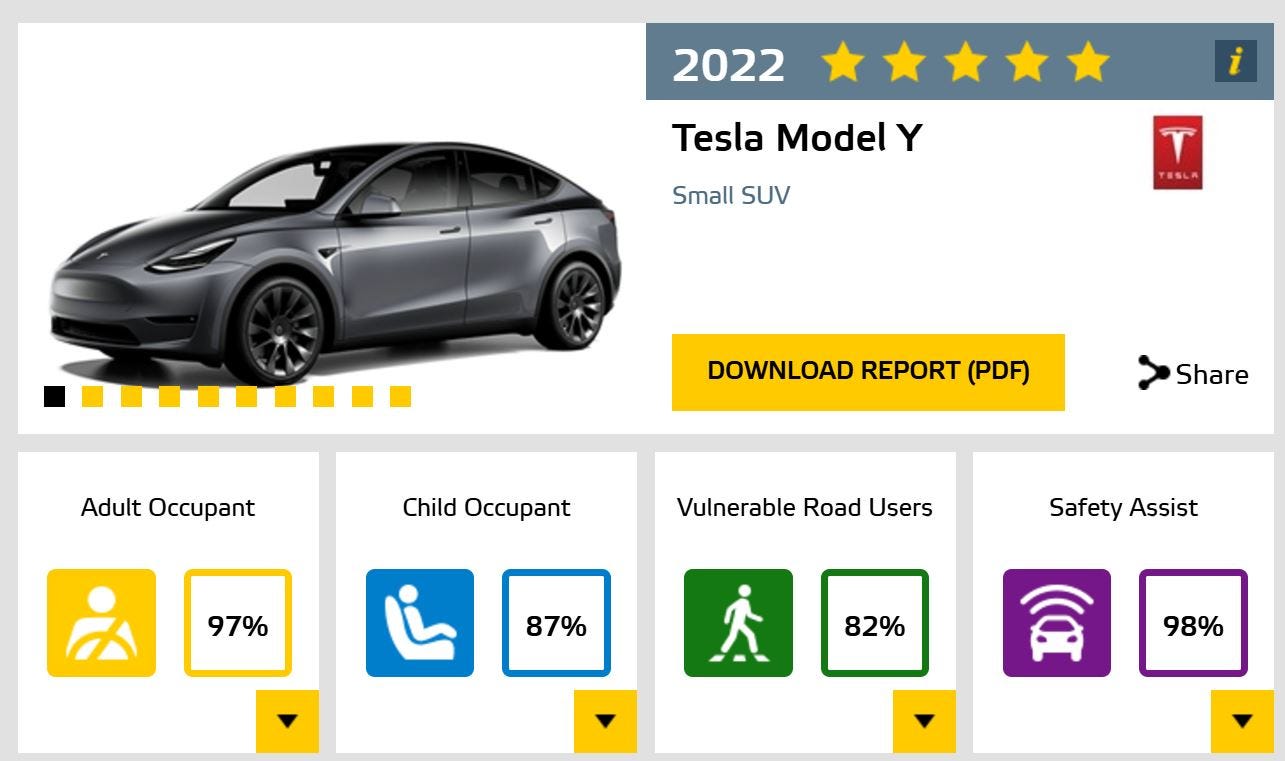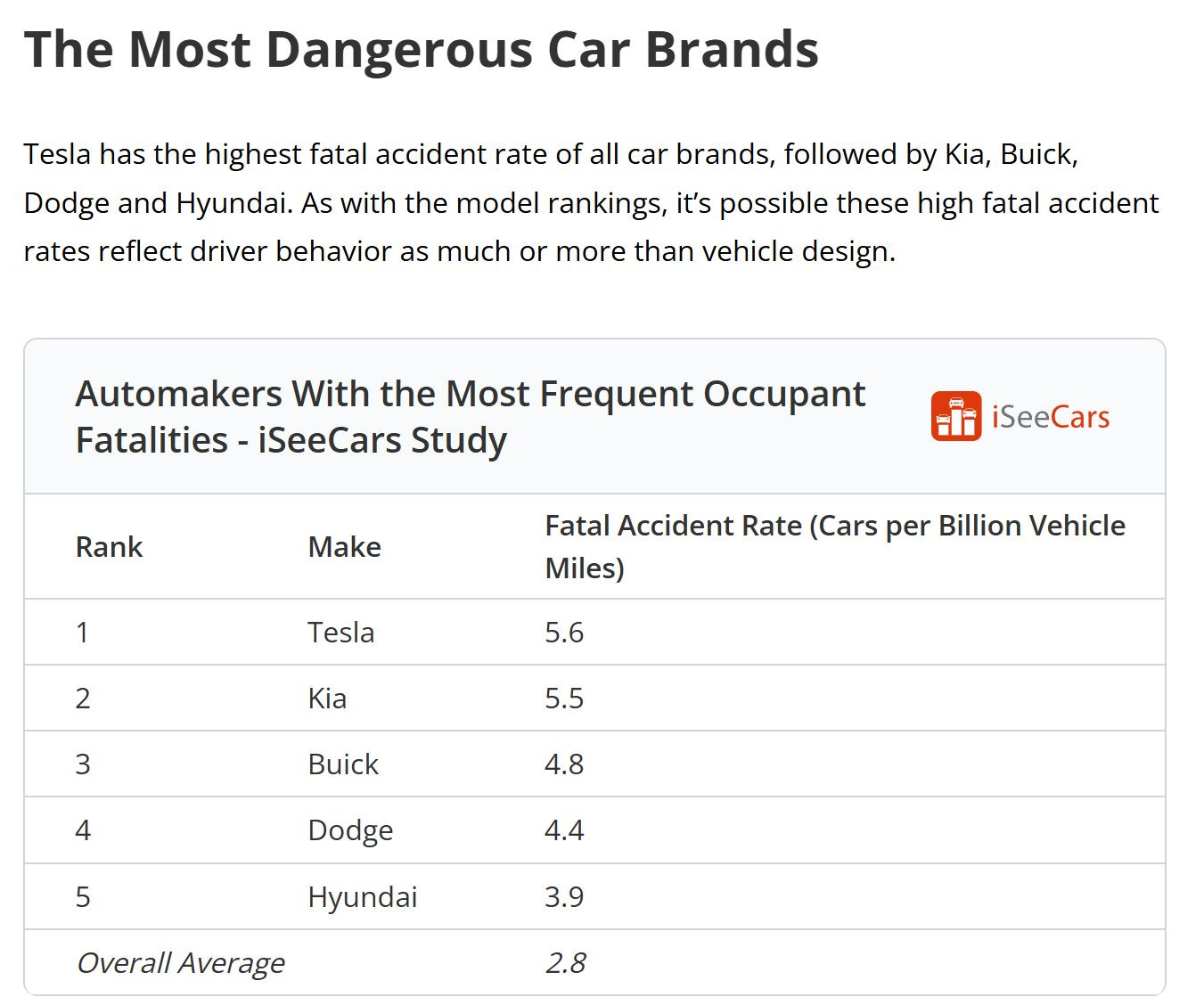Debunking Tesla "Safest Car On The Road" claims
Good NCAP ratings, but a new study shows Tesla is the most dangerous brand on the road for safety outcomes. And AutoPilot is not a safety feature. Here are the receipts.
TL;DR: Tesla has top safety star-ratings, but in practice has on-road safety outcomes ranging from mediocre to the worst when compared to same-year models. And no, AutoPilot is not making you a safer driver.
I regularly hear claims that Teslas are the “safest car on the road” and get asked what I think of those claims. Here, all in one place, is why those claims are as much marketing puffery as reality. Of course it’s a bit complicated. But overall, what I’m seeing shows net Tesla road safety outcomes range from middle-of-the-pack for new cars to among the worst, depending on your metrics.
(1) Tesla loves to brag about its 5-star crash testing results. But 5-star NCAP crash results are common, because that system no longer challenges automakers. (Note: NCAP just released some updates. So we’ll see how that goes over the next year or two.)
Also, crash testing is not the only predictor of real-world outcomes. I'd prefer my automated vehicle to not crash in the first place, thank you!
EuroNCAP is way ahead of NCAP in their methodology. And to its credit, Tesla comes out looking pretty good on recent EuroNCAP results (info for Tesla model Y):
Tesla Models S & Y got some best in class EuroNCAP awards, which is good to see. However, score differences among top vehicles are not huge.
The tricky part is when you compare a new Tesla to an “average” car, which is more than 12 years old these days. The reality is that pretty much any new car is MUCH safer than an average (12-year old) car. So if you want to improve safety, get a new car. Getting a Tesla is an incremental difference compared to other cars. Sure it looks good on the scores, and that’s fine.
(Details: EuroNCAP has not reported any Tesla score for 2023 & 2024. In 2022 Tesla Models Y and Model S scored the top two combined scores.)
But the question is how star ratings translate into safety (or not) on public roads. That’s where the story gets less rosy.
(2) About AutoPilot and safety: All Tesla and other car data I've seen to date (see Noah Goodall's paper: https://engrxiv.org/preprint/view/1973 ) suggests that any steering automation safety gains (e.g., Level 2 autopilot) are approximately negated by driver complacency, with autopilot on being slightly worse than autopilot off: "analysis showed that controlling for driver age would increase reported crash rates by 11%" with autopilot turned on vs. lower crash rates with autopilot turned off on the same vehicle fleet.
(3) Any true safety improvement for Tesla is good to have, but is much more likely due to comparison against an "average" vehicle (12 years old in the US) which is much less safe than any recent high-end vehicle regardless of manufacturer, and probably not driven on roads as safe on average as where Teslas are more popular.
Also, see Noah Goodall's point that Tesla omits slow speed crashes under 20 kph whereas comparison data includes those. If you're not counting all the crashes, it should not be a huge surprise that your number is lower than average -- especially if AEB type features are helping mitigate the crash speed to be below 20 kph. If there is a hero here it is AEB, not Autopilot.
(4) If you look at IIHS insurance data, Tesla does not rate in the top 10 in any category. So in practical outcomes they are not anywhere near number one. When I did the comparison a couple years back I found out a new Tesla was about the same as my 10-year-old+ Volvo based on insurance outcomes. (I have since sold that to get a vehicle with newer safety features, much better than same-model-year Teslas.) That suggests Tesla safety outcomes are years behind the market leaders in safety. However, it is important to realize that insurance outcomes are limited because they incorporate "blame" into the equation. So they provide a partial picture. IIHS Link: https://www.iihs.org/ratings/insurance-losses-by-make-and-model
(5) An older NHTSA report claiming autopilot was safer was thoroughly debunked: https://www.thedrive.com/tech/26455/nhtsas-flawed-autopilot-safety-study-unmasked
(6) Studies that show ADAS features improve safety are valid -- but the definition of ADAS they include does not include sustained steering of the type involved with Autopilot. Autopilot and FSD are not actually ADAS. So ADAS studies do not prove they have a safety benefit. Yep, AEB is great stuff. And Teslas have AEB which likely provides a safety benefit (same as all the other new high-end cars). But Autopilot is not ADAS, and is not AEB.
For example: https://www.iihs.org/topics/advanced-driver-assistance lists ADAS features but makes it clear that partial driving automation (e.g., Autopilot) is not a safety feature: "While partial driving automation may be convenient, we don’t know if it improves safety." Followed by a lot of detail about the issues, with citations.
(7) A 2023 study by Lending Tree showed that Tesla was the absolute worst at crashes per 1000 drivers. There are confounders to be sure, but this seems to reflect higher crash rate for Teslas than other vehicles even on a level playing field: https://www.lendingtree.com/insurance/brand-incidents-study/
(See the iSeeCars study below for more on this)
(8) In December 2023, more than two million Teslas were recalled due to safety issues with autopilot (NHTSA Recall 23V-838). The recall document specifically noted a need for improved driver monitoring and enforcement of operation only on intended roads (for practical purposes, only limited access freeways, with no cross-traffic). The fact that a Part 573 Safety Recall Report was issued means by definition the vehicles had been operating with a safety defect for many years (the first date in the chronology is August 13, 2021, at which time there had been eleven incidents of concern). Initial follow-up investigations by the press indicate the problems were not substantively resolved.
(Note that per NHTSA terminology, a "recall" is the administrative process of documenting a safety defect and not the actual fix. The over-the-air-update is the "remedy". OTA updates do not in any way make such a remedy not a "recall" even if people find the terminology less than obvious.)
(9) In November 2024, iSeeCars released a study based on NHTSA FARS data showing that Tesla was the top brand in terms of fatalities per mile for 2018-2022 model year cars. This was largely because a significant fraction of their fleet is the model Y, which had the #6 highest fatality rate per mile of all models studied. (The model S also featured in the top worst performers, and other models were not safe enough to make up the difference.)
It seems some Tesla proponents are contesting the math on this report. But there is no reason to believe any methodological limitations in the report would favor one car brand over another. Based on available information, comparative rankings are likely valid even if you don’t like their absolute computational results. I’ll update this if a bigger issue emerges beyond complaints by the loser. But I don’t hear Kia, Buick, Dodge, or Hyundai complaining…
Top marks in crash safety still does not prevent high fatality rates if people are driving recklessly, distracted, or subject to automation complacency. And we’re back to point (1): I prefer my safe cars to not crash in the first place.






Just read how Tesla is releasing a fleet of Robotaxis. For now there is a teleoperator to help drive it. This says volumes of how poorly designed this car is. It will never be self-autonomous and at best will be trying to compete with similar costs as other car hailing services such as Lyft. I don’t believe a remote teleoperator will be as safe as an on board driver. It will not be able to compete with Waymo which unlike Tesla’s Robotaxis uses LiDar and much safer. When the first reports of injuries and deaths come up it will negatively affect Tesla share price. Musk again puts cost savings above human safety. His refusal to install LiDar will be his undoing.
I’ll start my comment with a caveat—I’m not a vehicle safety expert. That said, I believe comparing cars, safety wise, is an exceedingly difficult endeavor (the number of variables is nearly infinite especially when automation is involved). Consequently, here I just want to share my experience as a long time Tesla driver.
As an enthusiast of electric transportation, I got a Tesla over 13 years ago (the only electric vehicle available at the time). I still own that car, which doesn’t have any automating features, and I can report no incidents, except for a couple of speeding tickets. Tesla, and I believe all other electric cars, require some adjustments of driving habits. For instance, these cars offer breath taking acceleration and employ regenerative breaking. You have to be very careful when your vehicle needs just 3 sec to accelerate from 0 to 60 mph. Otherwise, you will enter the statistics in the car crash category. Regenerative breaking is a great feature which increases the driving range particularly in heavy traffic. Once more, you need to be careful. If you try to recharge your battery by excessively avoiding using the brakes you may rear end the vehicle in front of you (AEB is certainly useful in this case, but my old Tesla doesn’t have it). Another aspect is that on slippery pavement, on snow for instance, an electric car may behave differently when regenerative breaking occurs, i.e., the vehicle may be less stable (particularly in the case of rear wheel traction). Again, the drivers must adjust. Based on my driving experience, it will take some time until automation will be able to cope with such details.
Finally, I think a comparison between the safety of electric vehicles would be interesting. However, the result may be biased, because the number of Tesla cars on the US roads is much higher than any other brand.